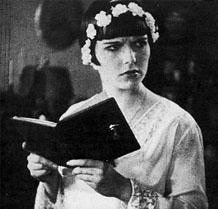
Louise in Pandora's Box
|
Pandora's Box was shot in five weeks, from mid-October until late November of 1928, largely a result of the unusual rapport between star and director. "I adored and worshipped Mr. Pabst," Louise Brooks once stated in an interview, adding, "Usually as mean and snarling as a wildcat, I sat up and wagged my tail for him like a little dog." And her respect for Pabst-the-artist knew no bounds: "I revered Pabst for his truthful picture of the world of pleasure which let me play Lulu naturally."
And, although she was met with animosity from fellow actors Kortner and Roberts, Louise got along famously with Lederer. Asked about her some 60 years later, the retired actor recalled: "I absolutely adored her. She was a mysterious person, perfectly cast for the part. My relationship with her was very distant. We couldn't talk! She didn't speak a word of German, and I didn't speak a word of English. We just looked at each other." Pandora's Box is now generally considered among the great silent screen classics, as well as Louise Brooks' finest performance. Not so in 1929, when it premiered in Berlin-and immediately encountered censorship problems. Everywhere it played, cuts were made in its continuity to soften the sexual content (tame, of course, by today's standards). For American audiences, an entirely altered ending rescued Lulu from Jack the Ripper's knife and saw her morally cleansed by joining the Salvation Army! |
Copyright: McKenna W. Rowe, 1997-2006